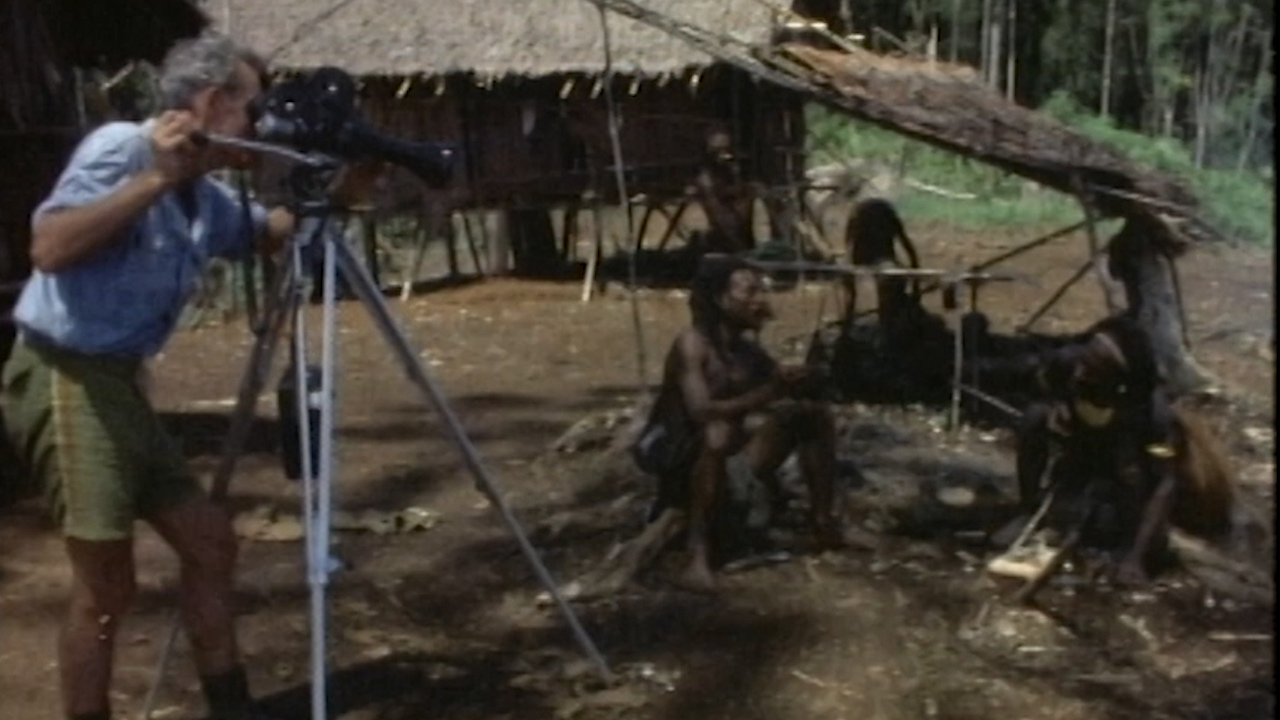
In the late 1960s, anthropologist Edmund Carpenter was hired as a communications consultant for what was then the Territory of Papua and New Guinea. Colonial administrators were seeking advice on how they might use radio, film, and television to reach, educate, unite, and “rationalize” remote areas of the territory as they moved toward independence. It gave Carpenter what he called “an unparalleled opportunity to step in and out of 10,000 years of media history.” He recorded and created some of the most remarkable events in local media history throughout the territory, such as the first times people actually saw their own photographs in Polaroids.
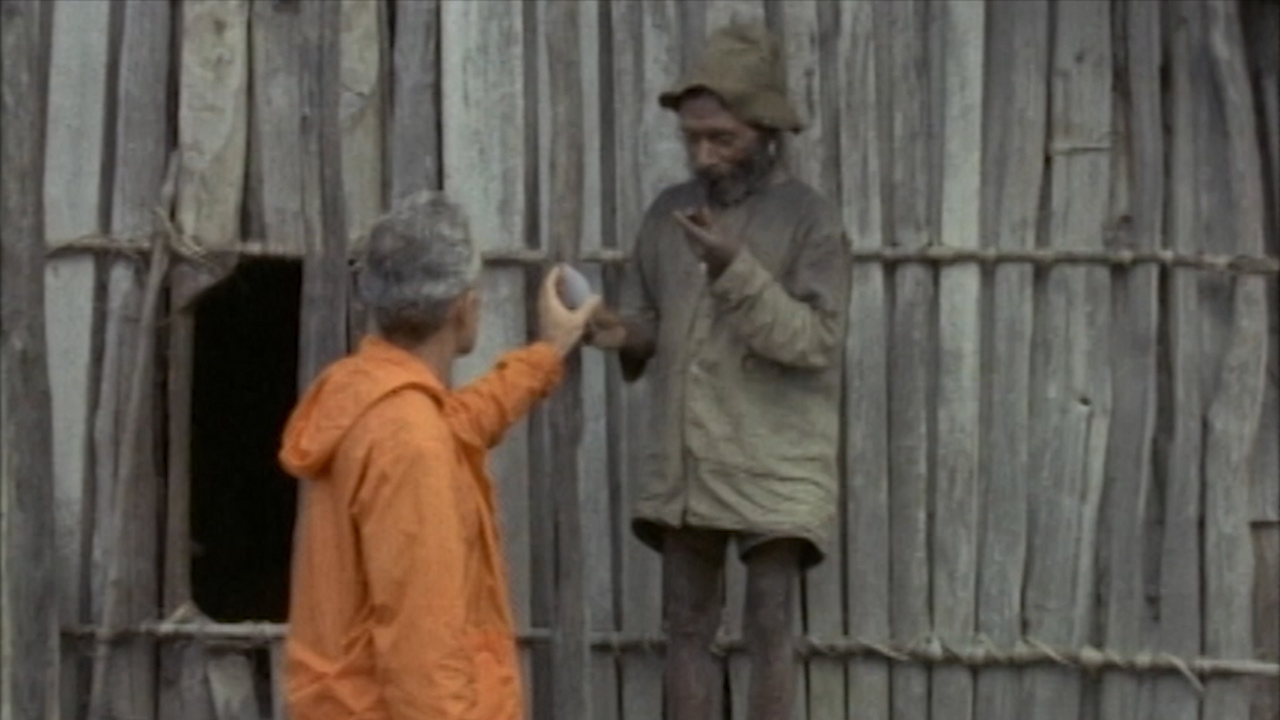
When I arrived in New Guinea 35 years later, I stepped off a plane onto a remote landing strip and walked one hour down a road made for cars that no cars travel, that goes nowhere, built as part of a government development project. It ends a few hundred meters from Telefolip, what was once the sacred spiritual center of the Telefomin people. I did not know that Edmund Carpenter had been there, but upon my first glimpse of the village, I immediately recognized it from a picture in Carpenter’s book. The picture, taken 35 years ago, features a movie camera sitting on a tripod in the center of the village. A Telefol man leans over hesitantly as if trying to steal a peek through the viewfinder. A young boy scurries out of the view of the lens. The sacred men’s house stands prominently in the picture. Today, it has fallen.

I reached out to Carpenter to find out more about his time in Telefolip, and he generously sent me copies of over 30 hours of film footage he took during his time in New Guinea. In one haunting sequence, he snaps Polaroids of two men standing outside their house and hands them the photos. Carpenter recounts that when he first gave people pictured of themselves, they could not read them. To them, the pictures were flat, static, and lifeless—meaningless. He had to point to features on the images and features of their own faces. Finally, “recognition gradually came *into the subject’s face. And fear.”
You can see it in the film footage. The man with the hat suddenly seems self-conscious about the hat. He hesitantly takes it off, hesitantly puts it back on, and finally just stands awkwardly with his hat off, staring at the image and then back to the camera that took the image.
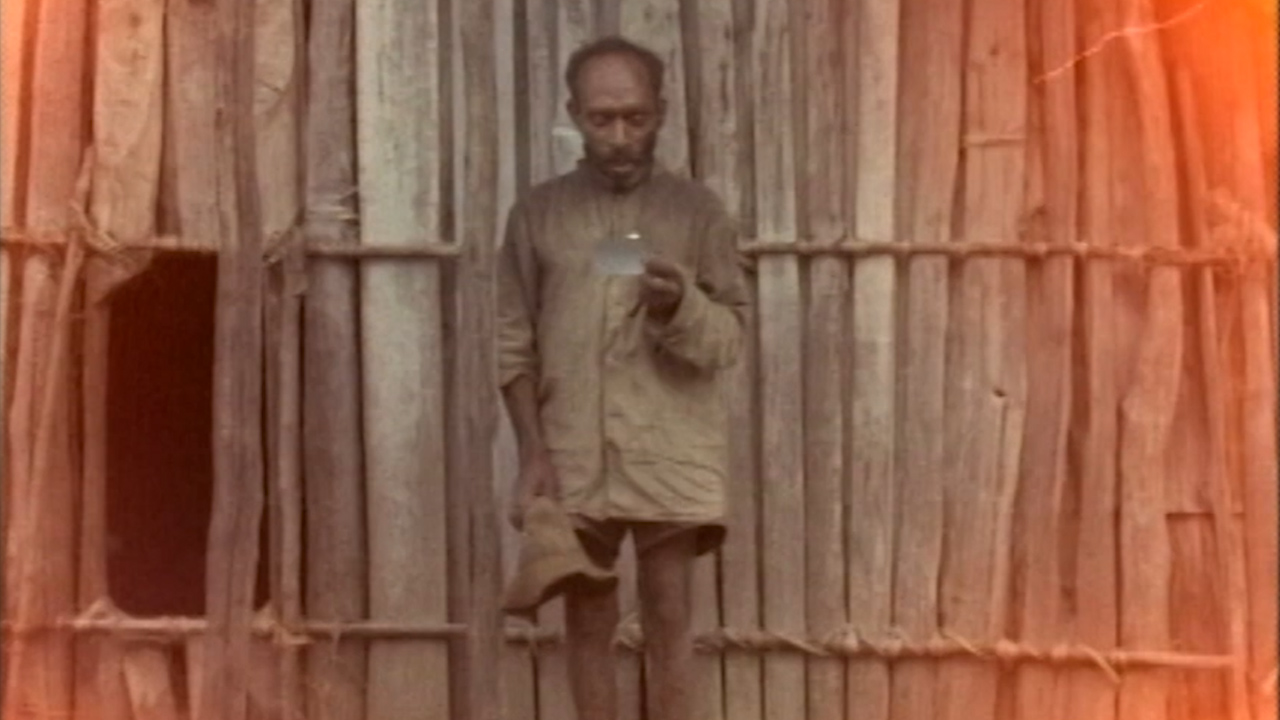
The other man retreats to a house to be alone, staring at his image for over 20 minutes.
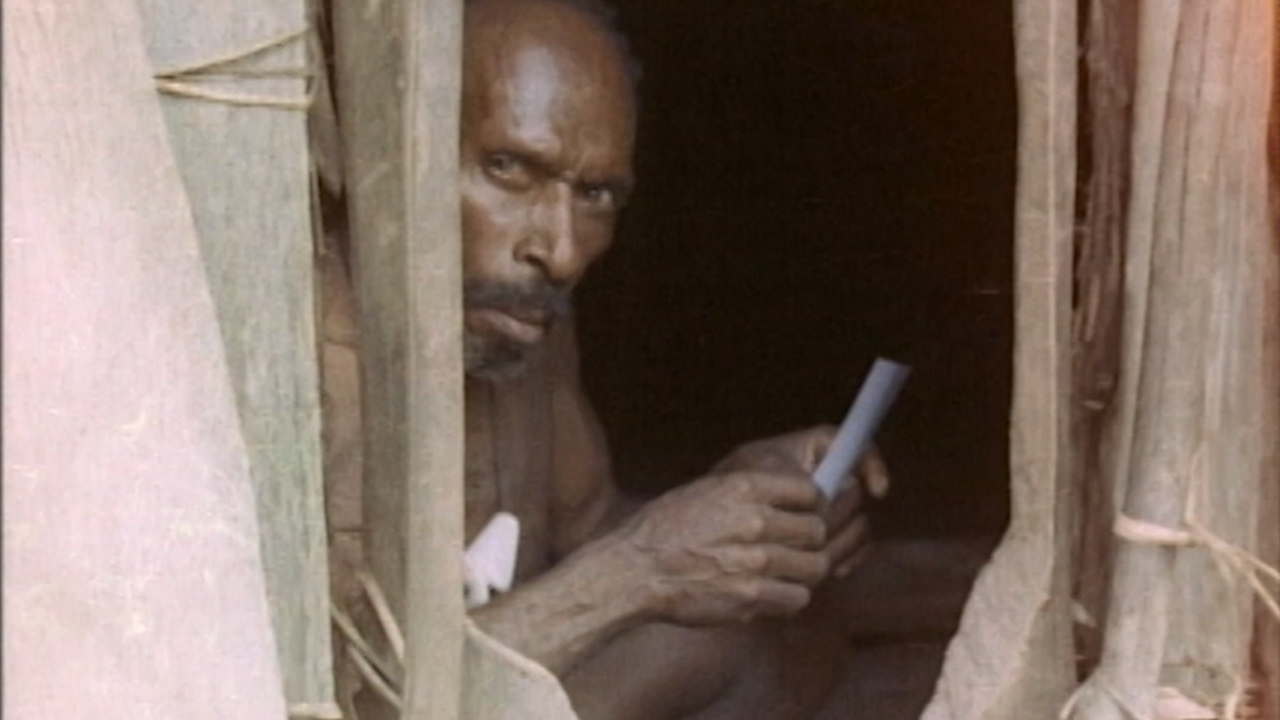
Carpenter describes their reactions as the “terror of self- awareness,” evidenced by “uncontrolled stomach trembling.” He describes the depths of the effect as one of “instant alienation,” suggesting that it “created a new identity: the private individual.” He argued that the Polaroid and other recording media created a situation in which, “for the first time, each man saw himself and his environment clearly and he saw them as separable.”
As an anthropologist, he understands that such a change is not likely to come from just one small event, but it participated in a whole host of other changes that were currently underway in New Guinea, such as the arrival of schools and missions, and the preparations to move toward national independence and self-government. Nonetheless, he could not shake the sense that these media forms were having dramatic effects on their consciousness.
He describes one village where he handed out Polaroids with great regret. He says that when he returned to the village months later, he didn’t recognize the place. “Houses had been rebuilt in a new style. . . . They carried themselves differently. They acted differently. . . . In one brutal movement they had been torn out of a tribal existence and transformed into detached individuals, lonely, frustrated, no longer at home— anywhere.”
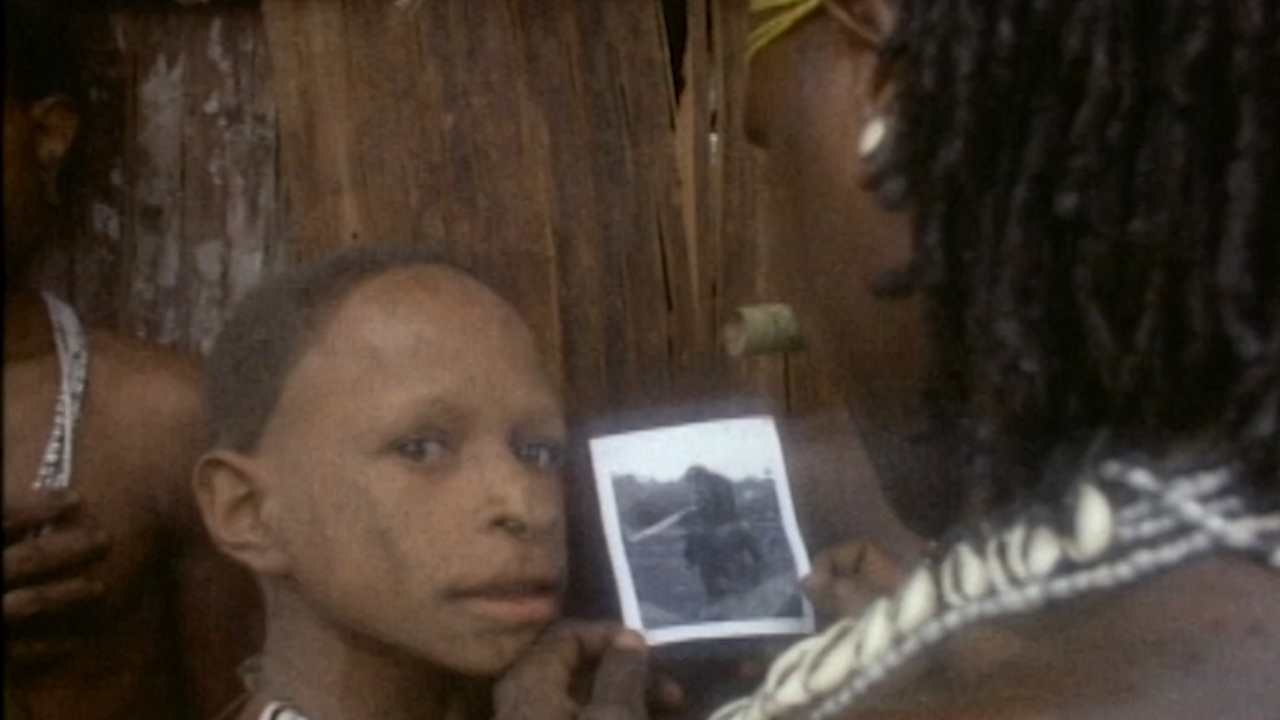
Such experiences left Carpenter disillusioned about the effects of technology, especially communication technologies, on indigenous peoples, and concerned about the effects of media everywhere. “I felt like an environmentalist hired to discover more effective uses of DDT,” he lamented.
When I stepped into the village thirty-five years later, the once-thriving spiritual center of Telefol life had been reduced to a ghostly shell of what it once was. The once magnificent men’s house had recently collapsed. There were no plans to rebuild.
The other houses have all been abandoned. The residents have moved into Western style pre-fab houses lined perfectly along that government road that doesn’t go anywhere. Powerlines power up
radios, televisions, refrigerators, and lights. Traditional houses have been made into “kitchens” reserved for cooking.
While powerlines had not yet reached the region of New Guinea where I ultimately settled in to do my research, many of my friends were eager for photographs of themselves and their families. I set up a simple solar panel system that gave me about two hours of power each day to write notes on my laptop, and a simple printer that I could use to print pictures. I took a picture with my brothers along with a middle-aged man, and then printed it to give to them. The older man looked at the picture and excitedly pointed to my brothers, naming them as he pointed. Then he pointed to the man in the middle, himself, and said, “Who is that?” He saw himself so rarely that he did not even recognize himself. I would see this happen over and over again. It rarely happened with younger people, who often had small mirrors they used for shaving or decorating their faces. But many older villagers did not grow up with mirrors, and have never sought to own one.
Contrast this with our own everyday practices. How many times per day do we engage in the practice of objectifying the self into an image? Or study the self in image form? How many glances into the mirror? How many Snapchats? How many scrolls through the photo gallery on our phones, Facebook, or Instagram?

It’s so often that we need not even be looking at a mirror or image. Most of us have a pretty good sense of how we look in our mind’s eye. We adjust this or that button, untuck our shirt just so, tuck our hair back behind our ear, or adjust our hat ever so slightly as we imagine how others might be seeing us at any given moment. We are constantly aware of ourselves as objects that are constantly under the scrutiny and judgment of others.

We take mirrors and photographs for granted, yet clearly they have a profound effect on those who have never encountered them. Is it possible that they also have a profound effect on us that has since gone unnoticed? What if you gave up mirrors and all images for a week, a month, or a year? Would your consciousness change?
His defense, although framed within the context of a generation ago and half a world away, should still resound with us today. “If this question is painful to answer when the situation is seen in microcosm,” he asked, how is it to be answered as millions of people are allowing new media to permeate their lives, “the whole process unexamined, undertaken blindly?”
His point is that we live a life completely immersed in technologies. But do we really understand how they shape us? We usually look at them as great comforts, wonderful conveniences, important necessities, or the source of fantastic experiences. But how do they change us? And how might we be different if we gave them up or if these technologies never existed?
“WE SHAPE OUR TOOLS, AND THEN OUR TOOLS SHAPE US.”
This quote from media scholar John Culkin is sometimes literally true. Over long periods of time, the interaction between humans and their tools can even reshape our DNA. Over the millions of years that we have been using hand tools, there has been an evolutionary advantage to having nimble and dexterous fingers. Over time, our hands evolved an ability to manipulate objects with increasing precision, allowing us to create more precise objects which in turn create an ever- increasing advantage on more precise hand control. Our hands and our hand-tools co-evolved in their complexity. Fire is another example of a tool that changed our DNA. Fire allowed us to cook our food so that we no longer had to spend hours of our day chewing fibrous meats and tubers. Over time, we can see in the skeletal record that our jaws have become weaker and less robust since the invention of fire.
The power of technologies to literally shape our bodies is beautifully demonstrated by this famous photo published by Phil Hoffman in The American Journal of Orthopedic Surgery in 1905.
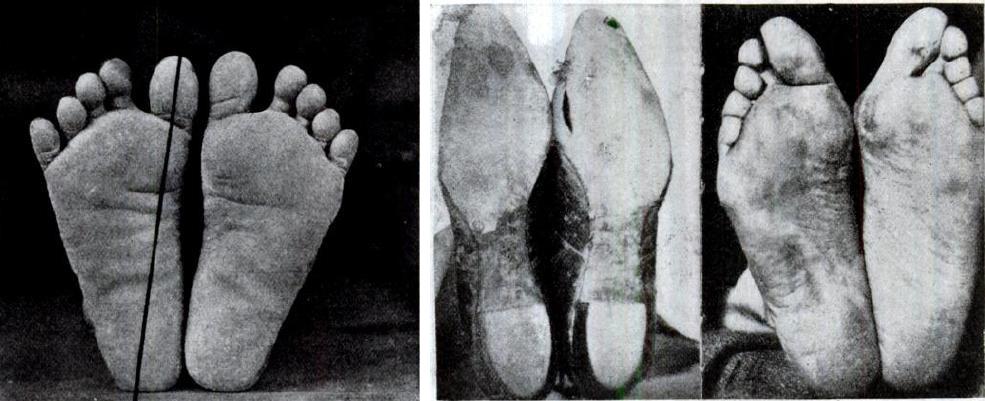
Shoes have not yet been around long enough to actually change our DNA. If you go barefoot long enough, or from a young enough age, you can also attain the amazing ability to spread your toes, engage all of your nature-given talents for balance and agility, and handle the roughest of surfaces without the aid of shoes. Similarly, coats and sophisticated climate controls like air conditioning and heating have reduced our ability to withstand cold and heat. Our comforts make us weaker.
The idea that “we shape our tools and then our tools shape us” is sometimes mistaken as a claim for technological determinism, the idea that technology determines how we live, think, and act. But it would be wrong to only point out how our tools shape us. As noted in Lesson Two, cultures are complex and interrelated in such a way that no one element completely determines the other elements of the system. Instead, each element “shapes and is shaped by” another.
As we noted then, modern capitalism shapes and is shaped by modern individualism. American individualism shapes and is shaped by the American political system. The American labor market shapes and is shaped by individualism. And so on. In other words, culture is made up of a complex web of relationships of “mutual constitution” and it is this idea that we point to with the phrase, “we shape our tools and then our tools shape us.”
We can now use the “barrel model” introduced in Lesson 2 as a guide to a profound set of questions about technologies and how they might affect us. At the level of infrastructure, how does a new technology shape our subsistence and economy? What other technologies will it make more important or necessary? What technologies might it displace and make obsolete?
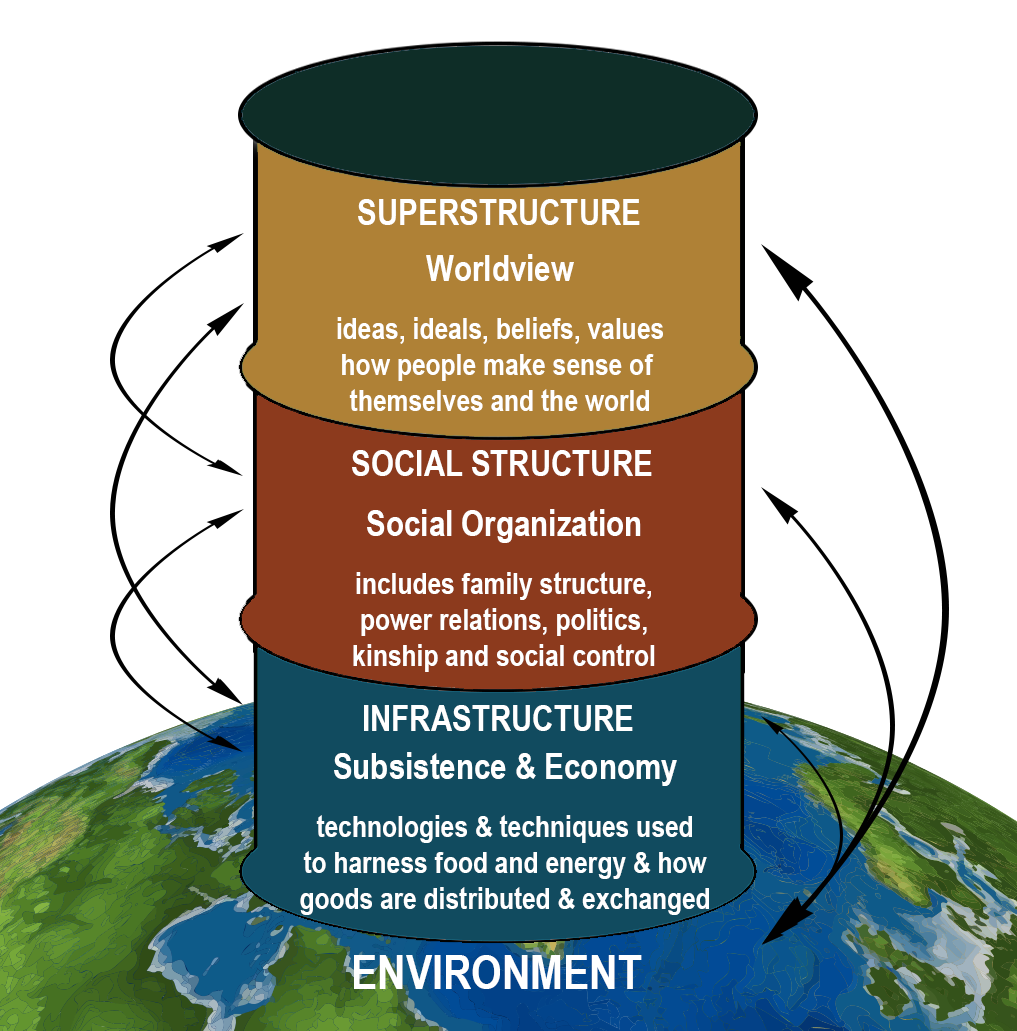
When one technology requires or strongly influences the adoption of another technology, we call it entanglement, and when you follow the lines of entanglement far enough, you arrive at the realization that a new technology can have far-reaching effects far beyond what was originally intended.
Take the example of clothing. In the late 1970s, the first clothes started to arrive in the New Guinea village through trade networks with neighboring clans where they had government aid posts and missions. Then, in the early 1980s, missionaries started bringing in clothes and giving them to the locals. Many people immediately converted to Christianity in hopes of receiving the luxurious goods, and missionaries worried that they might be creating “clothes Christians” – people whose faith was only worn on the skin and did not penetrate to the soul.
Though the clothes offered comfort and protection from the elements that the natives had never experienced before, they presented a host of new problems. First, they had to be washed, so they needed soap. They could not be dried effectively in their huts due to the smoke and the thatch roofs infested with insects hungry for cloth, so they needed new houses with tin rooftops. The tin rooftops required nails to hold them in place. The nails required hammers to nail them in. The tin was square and standardized, so they needed some basic geometry and trigonometry to design their new houses. Geometry and trigonometry required that they go to school. School required paper, pens, and backpacks to carry it all. And all of this required money. As it turns out, clothes are deeply entangled with a vast range of other technologies that would ultimately encourage remote New Guinea villagers to join the global economy.
There are examples of entanglement all around us. For example, if you take a walk starting from the center of my hometown of Manhattan, Kansas, you will notice that the homes near the center of town built prior to 1930 usually have large front porches and no garages. If they do have a garage it is almost always separated from the house and was built much later than the original house. The reason for the absence of the garage is obvious. The garage is a technology entangled with cars, of which there were very few prior to 1930. But what about the front porch? As we walk away from the town center and enter the neighborhoods built after 1950, suddenly the front porch is gone.

What happened? Air-conditioning. Large front porches allowed people to stay cool in the summer, and had the pleasant side-effect of creating “front porch culture” where people would sit and greet their neighbors, creating strong social bonds. The air-conditioner eliminated the need for these porches, and they disappeared, along with that sense of community. Now the most prominent feature on the front of most suburban homes is a large double-wide garage door.
This example makes it clear that technological change is not limited to technology. Technologies shape how we make a living (infrastructure), how we connect, collaborate, and interact with one another (social structure), and can even participate in a wide range of cultural changes that lead to new core values and beliefs (superstructure). To see how this can happen, let’s take a brief look at the last 12,000 years of human history.
“THE WORLD UNTIL YESTERDAY”
Humans have been hunting and gathering their food for over two million years. Viewed on that time-scale, it really is only yesterday that we were still living without most of the technologies we take for granted today. As Jared Diamond calls it, the world of hunters and gatherers is best understood as “the world until yesterday.” Up until just 12,000 years ago, all humans everywhere lived basically the same way. In the popular imagination we were hunters, and indeed we were. But the evidence suggests that we acquired the vast majority of our calories from foraging: gathering fruits, nuts, tubers, and other foods.

Our simple manner of making a living had significant effects on how we lived and what we lived for. Using simple tools such as baskets and string bags for carrying the foods they find, and bows, arrows, spears, and blowguns for hunting, a typical forager can produce only enough food for themselves and a small family. So we lived in small bands of no more than about one hundred people.
When an area was picked over, we needed to move to where the picking was better. When a herd moved on, we needed to move with them. So we lived with few possessions that might weigh us down.
This basic pattern of life was the foundation of all human life for over two million years. There were a few key inventions that changed human life over the course of these two million years; fire about 400,000 years ago, language about 200,000 years ago, and the “Creative Explosion” about 50,000 years ago that brought about the first clothing, fish nets, art, and more sophisticated stone blades. But the foundation of our survival, the way we harnessed energy from the Earth, remained foraging and hunting.
There are very few foraging cultures in existence today, but we can learn something from the few that we do observe. Most remarkable is their vast knowledge and awareness of the natural world. Wade Davis tells of a Waorani hunter in the Ecuadorian Amazon who could smell and identify the urine of an animal from up to 40 paces away. Foragers manage to find food in even the most extreme environments. The San Bushmen of the Kalahari desert in southern Africa notice small things that you and I would not notice in their desert landscape that allow them to track wild game for miles or that tell them where to dig to retrieve roots and tubers. Some tubers can be squeezed to retrieve water in a landscape otherwise devoid of this basic human necessity. At the other extreme, Inuit of the Arctic look for subtle signs on the barren white ice that indicate where a seal might be coming up to breathe. They make a small hole in the ice and wait, spearing the seal as it comes up for a breath. To you and me, it looks like these people are pulling something out of nothing.
Since their mode of subsistence can only support a small, sparse population, the social structures of these societies are simple and informal compared to the complex bureaucracies and government systems of modern states. The average person in a remote band will almost never encounter a stranger. Disputes can be settled without the need for formal laws, lawyers or judges. Social order can be maintained simply by the mutual desire to maintain good relationships with one another and to support one another as needed. With no need for formal social institutions, there are no formal leaders, no offices to hold, no authority to lord over others.
There is no need for money or marketplaces. People simply gather food and share it with others in a gift-based economy. In a gift-based economy, you benefit by giving to others when you have more than you need because you know they will give back when they have more than they need. In this way, giving a gift provides insurance against hard times. As such, people in gift economies place a high value on their relationships, which can feed them when the going gets rough, rather than material goods that are simply burdensome to carry around and may mark you as wealthy and burden you with requests for gifts from others.
This value on relationships extends to the natural and animal world as well. Hunting cultures revere the animals they hunt. They are deeply thankful for them, and offer thanks to the animals they kill for giving themselves to them. Their myths and rituals celebrate the animals and often speak of a covenant made between the hunters and their prey. For example, the Niitsipai of North America (often referred to as the Blackfoot) tell the story of a young girl who offers to marry a bison if the herd would just sacrifice themselves so her people could survive. The bison agree to this and teach her their song and dance of life, the famous “buffalo dance,” which they perform so the bison will continue to give themselves to the people in exchange for renewed life through the dance.
The tools we use take a role in shaping all aspects of their lives, from the way our societies are ordered and maintained, to our core values, religious beliefs, rituals, and knowledge.
Though they lack the technologies and material goods that we associate with wealth and affluence, Marshall Sahlins once described them as “the original affluent society.” Studies of their work habits show that foragers only work to gather food for about 15 to 20 hours per week, and this “work” includes hunting and berry-picking, activities that we consider high-quality leisure activities. Indeed, most of them do not distinguish between “work” and “leisure” at all. Their affluence is not based on how much they have, but in how little they need.
A popular story illustrates the point nicely. A rich businessman retired to a fishing village in Mexico. Every morning, he went for a walk and saw the same man packing up his fishing gear after a morning of fishing. He asked the man what he was doing. “I caught some fish to take home to my family. I’ll take a siesta while they cook this up, wake up to a nice dinner, and then pull out my guitar and sing and dance into the night. Then I’ll wake up and do it again.”
“I’ll tell you what,” the businessman said. “I have been very successful in my life, and I want to pass on all my knowledge to you. Here’s what you need to do. Fish all day, and have your wife sell the surplus at the market. Save your money and buy a boat so you can catch more fish. Save that surplus and buy a whole fleet of ships. Eventually you can invest in a packaging and supply company and make millions.”
“That sounds good,” the fisherman said. “Then what?”
“That’s the best part. You sell your business and all of your assets, buy yourself a nice little cottage on a beach in Mexico, go fishing every morning, take siestas, wake up to a nice meal and then pull out your guitar and sing and dance into the night.”

THE LUXURY TRAP
A Brief History of the past 12,000 Years
Starting about 12,000 years ago, humans domesticated plants and animals and started farming and raising livestock. Wheat, barley, pigs, goats, sheep, and cattle were domesticated in the Middle East. Maize, manioc, squash, gourds and llamas in the Americas. Taro in New Guinea. Rice, beans, and pigs in China. All over the world, simultaneously and independently, foragers shifted from their nomadic way of life and settled into growing villages to cultivate crops.
Given the apparently idyllic life of leisure, hunting, and gathering berries, why did humans start farming, build massive cities, complex technologies and burgeoning bureaucracies that ultimately sentence our youth to 13 to 26 years of schooling just to understand how to live and operate in this complex world?
Of course, the apparently idyllic life of foragers that provided ample leisure time was also riddled with the dangers of infectious disease, dangerous animals, deadly accidents, intertribal violence and unpredictable weather patterns that could reduce food and water supply. Infant mortality rates were high, and it was difficult to provide adequate care for elders if they were lucky enough to live that long.
But the life of an agricultural peasant a few thousand years later was probably worse. We know that the turn toward agriculture eventually led to the tremendous wealth of our current times, but agriculture did not produce this wealth overnight. The first farmers would have faced the same dangers of infectious diseases, animals, accidents, violence and weather of their foraging ancestors, but instead of walking around picking berries and hunting, they made a living by toiling in the fields under the brutal sun. They became dependent on a diet with fewer foods and nutrients. So we’re back to the original question. Why did we do it?
The answer proposed by Yuvaal Hurari, author of the recent best-seller Sapiens: A Brief History of Humankind, is that humans fell into what he calls “The Luxury Trap.” One generation reasons that it will make their life easier if they domesticate and plant a few seeds so they can establish more permanent villages. Life is good and food is plentiful for several generations. But as the carrying capacity rises, the people have more children. After a few generations, what started out as a luxury has become a necessity. Eventually the land can barely support the burgeoning population, and people have to work harder than ever to make a living.
Once humans started planting crops, the same piece of land that could support a few dozen people could support a few hundred. And once humans started irrigating that land and using animal-pulled plows, that same piece of land could support a few thousand. As Harari notes, the same area that could support about a hundred “relatively healthy and well- nourished people” hunting and foraging could now support “a large but cramped village of about 1,000 people, who suffered far more from disease and malnourishment.”
It didn’t matter that life was harder, less enjoyable, and more precarious for the agricultural peasant than it was for the nomadic forager. There was no going back.
“The trap snapped shut,” as Harari says.
The broad sweep of changes that came along with the domestication of plants and animals were so revolutionary that they are often referred to as the Neolithic Revolution. Growing societies required increasingly complex institutions to manage them. Government, law, taxes, markets and bureaucracy were all formed in the wake of the Neolithic Revolution. Over time, the clear trend was toward greater production and wealth, a greater diversity of products to consume with this wealth, and a greater diversity of jobs to produce the goods, manage the wealth, and provide services to an ever-growing population. But there were negative effects as well. These farming societies were less efficient than our foraging ancestors, burning far more energy per human. Social and economic inequality rose, and we worked longer and harder than ever before. For better or worse, human society and culture was forever changed.
The changes of the Neolithic Revolution set the stage for another revolution nearly 12,000 years later: the Industrial Revolution. As revolutionary as the domestication of plants and animals might have been, most of what we take for granted today was still not in existence just 250 years ago at the dawn of the Industrial Revolution. At that time, over 90% of humans were working in agriculture. Today, less than 40% of humans are farming, and the number is as low as 2% in industrialized nations like America. The Industrial Revolution ushered in an age in which more work would be done by machines than by muscle. Before the Industrial Revolution there were no cars, planes, phones, TVs, or radios. No suburbs, parking lots, or drive-thrus. No Coke, Pepsi, or Starbucks. No grades or compulsory schools. No Prozac, Zantac, or Zoloft. No Tweets, Snaps, or Finstas. No texting or emojis.
But by far the most dramatic change that occurred in the wake of the Industrial Revolution was what Harari calls “the most momentous social revolution that ever befell humankind: the collapse of the family and the local community and their replacement by the state and the market.”
Prior to the Industrial Revolution, Harari estimates that less than 10 percent of the products people commonly used were purchased at the market. People were still mostly reliant on their families and communities for food, shelter, education, and employment. When they had trouble, they turned to their families. As Harari summarizes, the family was “the welfare system, the health system, the education system, the construction industry, the trade union, the pension fund, the insurance company, the radio, the television, the newspapers, the bank and even the police.”
New communication and transportation technologies enabled markets and governments to provide these services in ways that enticed people out of the security of their families and into the marketplace as individuals. People became more mobile – physically, socially, and morally. But, as Harari notes, “the liberation of the individual comes at a cost.” Our strong ties to family and community started to wither, a trend that has continued to the present day.
We are enculturated to think of technological change as good, but all of these technologies and changes have some negative side effects, and many of them can be understood in terms of Harari’s notion of the luxury trap. For example, cars were invented to make it quicker and easier to get from one place to another. In response, Americans spread out into the countryside, creating suburbs, and now spend nearly a full hour getting to and from work on average.

In some cities, the average is nearly two hours, more than eliminating the supposed advantage of the car. Our communities transformed to accommodate the car. By far the largest public spaces sponsored by tax dollars are highways and parking lots. In order to accommodate cars, our communities had to spread out into the familiar suburban sprawl. In many suburbs, basic services and necessities are no longer reachable on foot, and the car, which was once a luxury, has become necessity. People rarely walk anywhere, reducing our physical health while also making it less likely for us to know and interact with our neighbors. That trap has snapped shut too.
Humans also produce over 300 million metric tons of plastic every year, some of which is drawn by ocean currents into the Great Pacific garbage patch, an island of trash bigger than the state of Texas.

Carbon dioxide levels continue to rise due in part to the burning of fossil fuels, raising global temperatures and leading to more extreme weather events. Sea levels have risen seven inches over the past 100 years, and in the next 100 will rise high enough to threaten major cities such as New York, Mumbai, and Shanghai.

Overall, our impact is so great that we will leave a lasting imprint on the earth. The International Commission on Stratigraphy is debating whether or not to formally declare that we have entered a new epoch in the history of the earth, the Anthropocene.
We know that we simply cannot go on living as we do without burning through our resources and disrupting climate patterns to a point that the earth may not be hospitable to human life. For these reasons, Jared Diamond once suggested that what appeared to be our greatest technological triumph, the domestication of plants and animals that set all of these forces in motion, might actually have been our greatest mistake.
A POST-HUMAN FUTURE?

We now sit at the brink of what many think is yet another revolution in human affairs. One harbinger of what might be to come is the supercomputer Watson. Developed by IBM, in 2011 they set it up to compete against the greatest Jeopardy players of all time. As the 74-time Jeopardy champion Ken Jennings fell further and further behind, he conceded the match in the final round by writing on his final answer, “I for one welcome our new computer overlords.”
Computers are becoming more powerful every moment. They drive cars, do taxes, trade stocks, manage complex budgets, play chess, write music, and even write articles we read in newspapers and online. They are even addressing problems and challenges that we struggle to comprehend. Scientists at Cornell University created a computer program, Eureqa, which can analyze large data sets to find patterns and create formulas that match the data. Eureqa has been able to discover formulas that scientists could not, and sometimes even finds a formula that works, but scientists don’t understand why it works.
The stock market is now dominated by computer algorithms, with over 75% of all trades being made by computers. Computers read headlines and make trades based on incoming news in milliseconds, before a human even has time to finish reading the headline.
As CGP Grey notes in his video, “Humans Need Not Apply,” humans have spent years creating “mechanical muscles” (large machines) to augment and replace manual labor.
Now “mechanical minds” are making human brain labor less in demand. Some robots have already taken jobs. ATMs are so ubiquitous they have become invisible, but they replaced many human bank tellers. Similarly, self-checkout machines at supermarkets are reducing the demand for cashiers.
Uber already has self-driving cars picking up passengers in cities around the United States. This may be disruptive to our culture in ways that we cannot yet comprehend. Without labor costs, Uber may be able to offer luxurious and convenient rides for anybody anywhere for a cost so low that fewer people will decide to purchase a car. Just as the Internet has started to provide meta-data and signals meant only for robots, so our cities might soon be redesigned to accommodate robot drivers. But even this is too limited a vision. Self-driving cars are really part of an automated transportation and delivery system that will be able to ship everything everywhere – by land, air, and sea, a system which currently employs more people than any other major economic sector in the United States. Within the next ten years, the demand for labor in this sector could collapse.
Meanwhile, software algorithms are reducing the demand for tax professionals, lawyers, journalists and many other fields. And Watson is not only great at Jeopardy. Watson works in the medical field, and some see it as the predecessor of a future “Dr. Bot” that will provide sophisticated personal diagnoses.
Some bots are even producing creative works like art and music. David Cope, a professor of music at UC Santa Cruz, has developed a computer program that can analyze scores of music from a particular composer and then create new music that sounds like it was written by that composer. The music is good enough that it has fooled top music critics and professionals into thinking it was produced by a talented human.
In short, it appears that if you are not in the process of creating an algorithm, you might be replaced by one. And of course, even your job as a software engineer creating algorithms might not be safe. Already, many engineers create learning algorithms that are designed to write new algorithms on their own.
Some see this as the beginning of what is called “the Singularity.” The Singularity is a state of runaway technology growth, a point beyond which human thought can no longer make sense of what is happening. Futurists like Ray Kurzweil think this moment is coming soon – within our lifetimes – and it will arrive when a machine is created that is smart enough and capable enough to design and create its own replacement. At that point, the replacement will design and create its own replacement, and that replacement will create its replacement, and so on, with each one better than the last, so that within a very short period of time there will be a computer so intelligent and capable that humans will be baffled by its power. We will likely have no way of comprehending it other than in divine terms. We will probably think of it as a god.
Kurzweil also predicts that as computers continue to become smaller and faster at an exponential rate, we will soon have molecular-sized nanobots operating in our bloodstreams to battle disease. He believes that advancements such as these will allow people alive today to live well into their 100s, and he predicts that by then we will have non-biological alternatives for living matter that will replace our bodies and allow us to live forever.
He also predicts that nanobots and other technologies will enhance our cognitive capacities and allow us to enter fully immersive and realistic virtual realities. We will be able to act and move in these worlds just as we do in the real world, but these worlds could be populated by artificial intelligent beings, or other humans who have entered the world with us – much like an MMORPG – but it will feel entirely real. Noting that millions of ordinary people are already spending more time in virtual worlds than they do in the real world, Edward Castranova predicts that we may see a mass exodus to the virtual world.

All these changes bring up fundamental questions about what it is to be human. Kurzweil and his colleagues are transhumanist. They are on a quest to enhance human capabilities and overcome disability, disease, and death. It may sound crazy, but we are all transhumanist in a sense. We all support and believe in the fight against cancer and other diseases. We support and believe in treatments that allow people with disabilities to live with them or overcome them. And we do everything in our power to avoid death for ourselves and loved ones, assuming our health is good. As science and technology progress, will we eventually draw a line and say: beyond this, we let people die? Beyond this, we let people suffer with their disability or disease?
And what if we do overcome death? Will life still have the same meaning? If you were going to live forever, would you be in school right now? And what are you in school for, if all the jobs are done by robots? It could create an existential crisis in which we lose our sense of meaning and significance. Others think that this future may create a literal existential crisis, in which hyper-smart and logical robots realize that humans are a drain on the planet and reason that there is no reason for our existence at all.
Perhaps we should be grateful for our limits. Our limits may bring us pain, struggle, and suffering, but they also bring meaning to our lives.
LEARN MORE